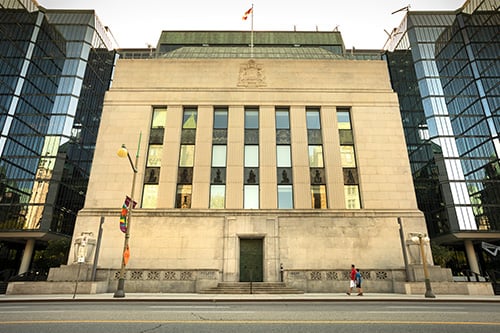The BoC has been clear with its intentions for the country's economic rebound from COVID-19

On Wednesday, the Bank of Canada will be releasing its scheduled overnight rate decision as well as its quarterly Monetary Policy Report. With the BoC adopting a low-rate approach to counter the destabilizing impact COVID-19 has had on the country’s economy, it would take a miracle for the Bank to change the overnight rate from where it currently stands.
“[B]ack in March, the Bank rapidly lowered our policy interest rate to 0.25 percent,” new BoC governor Tiff Macklem said in comments that accompanied the previous rate decision on June 22. “This action was not really expected to boost spending in the early days of the pandemic. Its immediate purpose was to help support confidence and provide some interest rate relief. But as more retail businesses reopen, low interest rates will help support spending.
“The policy rate is now at its effective lower bound. Some central banks have taken their policy rates below zero. We feel that bringing that rate into negative territory could lead to distortions in the behaviour of financial institutions.”
With the overnight rate expected to remain in place, it begs the question: What will it take for rates to finally start trending upward?
“I don’t believe they will raise rates until we are close to full employment, and inflation is at least two percent on a sustained basis,” says DLC’s Dr. Sherry Cooper.
According to Michael Gregory, deputy chief economist and head of U.S. economics at BMO, it will take a combination of positive indicators, including low inflation, a more favourable output gap, and a vastly improved employment situation to boost rates. It could be a while before these metrics align.
“I really can’t see rates moving up for at least two to three years,” he says.
With the overnight rate a more-or-less foregone conclusion, Gregory expects the Monetary Policy Report to be a little more tantalizing. Rather than being a straight-up forecast, something the BoC also avoided in June, Gregory thinks the MPR may delve into the various potential scenarios facing the Canadian economy, with a focus on recovery rather than recession.
“I think it’s very appropriate now to talk a little bit about the recovery,” he says. “The numbers suggest this was the shortest recession in history.”
Seeing as tomorrow will be the first opportunity for Tiff Macklem to take full control of the Monetary Policy Report, Gregory is expecting some subtle differences in terms of the new BoC governor’s approach.
One potential change he is eager to see is an increased show of forward guidance, where the Bank outlines certain benchmarks that must be reached before major policy moves can be initiated. It’s a strategy Gregory says could be used to prevent the marketplace from jumping the gun and making speculative moves in anticipation of future BoC decisions.
“They may want something to prevent those extrapolative expectations from getting out of hand,” he says, adding that observers shouldn’t expect anything “too specific.”
Cooper also expects the Bank to avoid its traditional, detailed forecast. She anticipates that the MPR will reveal a decline in Q2 GDP in the minus-20 percent range.
“The Bank will write that the recovery will be long and bumpy and will depend on the virus and timing of a vaccine,” she says.



